The Five Islands of the West Sea lie at the heart of the maritime border separating the two Koreas. Most of the major military clashes since the Korean War have occurred in the waters around these islands. However, with tensions easing somewhat, the islands are beckoning you to visit.
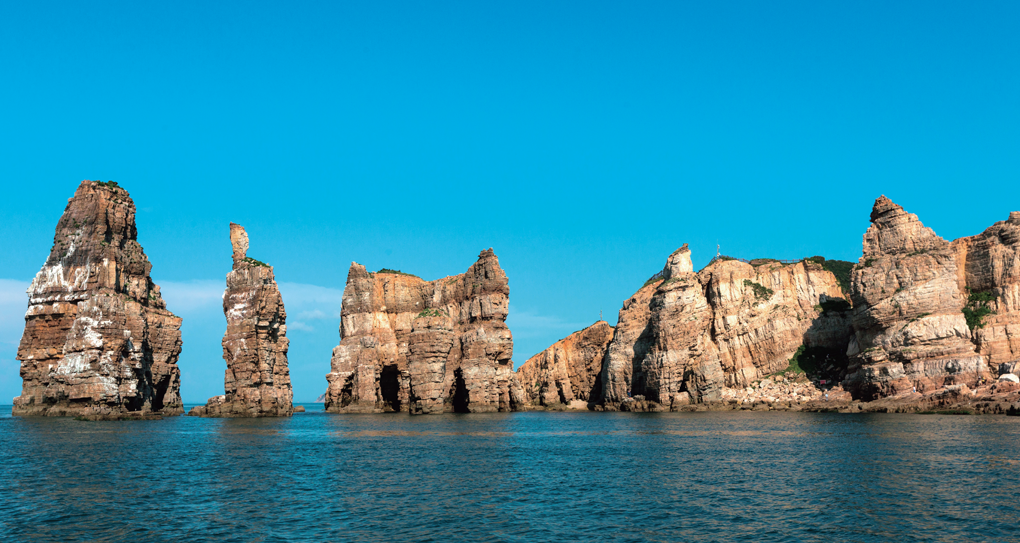
Dumujin Harbor on Baengnyeong Island, the largest of the five West Sea islands, features magnificent cliffs along a 4km stretch of coastline. Facing North Korea, the island is marked by military tension, but many tourists come nevertheless to view the spectacular scenery. Ten scenic spots on Baengnyeong, Daecheong and Socheong islands were named National Geoparks in July this year.
The day’s first ferryboat to Baengnyeong Island slides out of Incheon Harbor at 7:50 in the morning. Passengers are weighed down. Luggage is strapped to their backs and their hands are filled with bundles.
The air is full of anticipation and excitement. What’s on the lunch menu today? Baengnyeong-style naengmyeon (buckwheat noodles in cold broth) and kimchi tteok? Or perhaps a plate of fresh sea cucumber and pallaeng-i jjim, a dish of young stingray steamed and covered with sauce?
If any first-time passengers appear both curious and cautious, it is understandable. After all, the ferry is heading straight into the main military flashpoint of the divided Korean peninsula.
The Korean War ended in 1953 with an armistice that established the Military Demarcation Line (MDL). It is not far from the 38th parallel north, the artificial border that separated South and North Korea after World War II. The two Koreas’ claims over various islands were restored. However, Baengnyeong and four other islands in the West Sea (Yellow Sea) north of the MDL — Daecheong, Socheong, U and Yeonpyeong — were placed under the United Nations Command, which declared a maritime border called the Northern Limit Line (NLL) between the islands and south Hwanghae Province in North Korea. Before, the islands seemingly had little interaction. Now, they are bound together as Seohae Odo, or “Five Islands in the West Sea.”
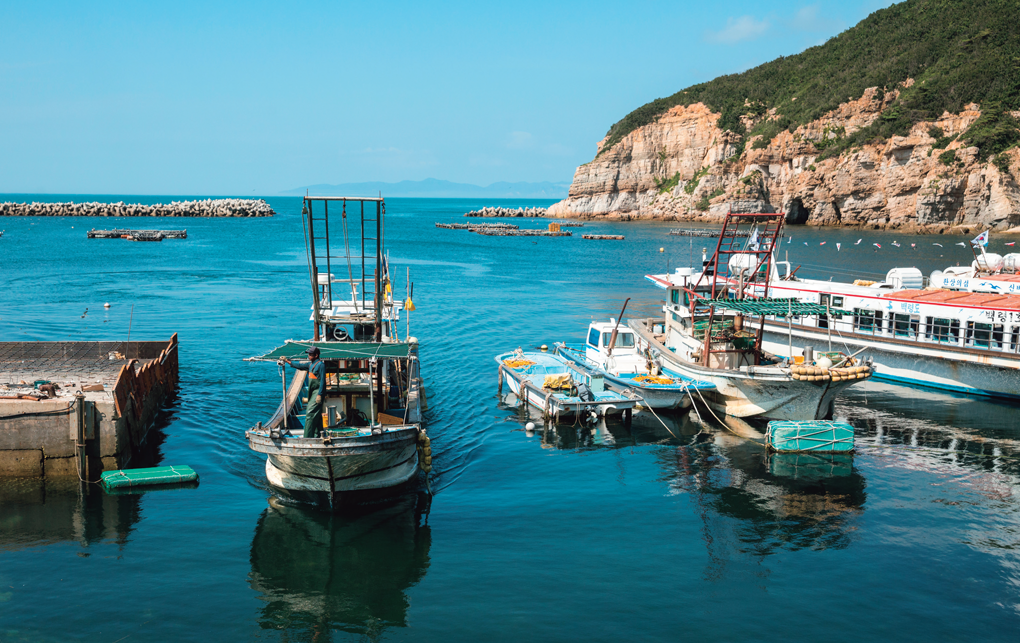
Sahang Harbor on the northwest side of Baengnyeong Island is a renowned fishing spot where sand lances are caught in abundance.
From Hostility to Reconciliation
The only way to get to the five islands is by ferryboat. Three round trips are made daily from Incheon Harbor to Baengnyeong Island, with stops at Socheong and Daecheong islands in between. Baengnyeong literally means “white feather”; its 51-square-kilometer area is shaped like a flying ibis. At some 200 kilometers by boat from Incheon, it is the farthest island in the archipelago. Assuming the sea is not rough and the ferry can average 30 knots, a one-way trip takes four hours, far less than the 12 hours it took in the past. Yet, strong winds and thick fog frequently keep the ferries moored.
Baengnyeong Island is only 16 kilometers from Cape Changsan in North Korea, and Yeonpyeong Island is 10 kilometers from the North Korean port of Pupori. Practically every South Korean fisherman trawling near the islands has personal stories about straying into North Korean waters on a foggy day and scrambling to get away.
From the North’s perspective, the five islands are a thorn in their side. Haeju, the southernmost military outpost of North Korea, can be observed from Yeonpyeong Island with the naked eye and the movement of North Korean navy ships obviously can be tracked from the islands. North Korea has never accepted the NLL, and in 1999, it declared its own maritime border, dubbed the “West Sea Maritime Military Demarcation Line.” It runs south of the MDL and twists northward to barely exclude the islands.
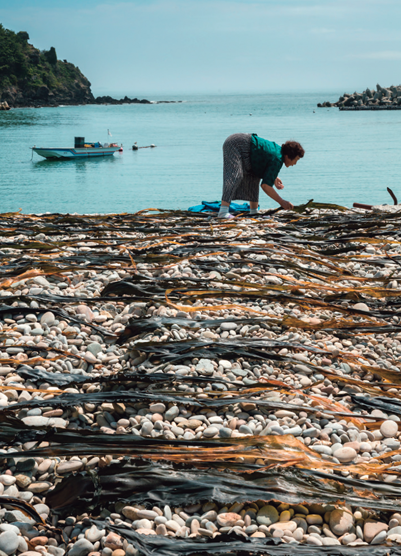
A villager dries kelp harvested by the seaside in Junghwa-dong. The village is home to the second oldest Presbyterian church in Korea.
In recent years, the biggest military confrontations between the South and North have occurred around these islands. On March 26, 2010, a South Korean Navy ship sank near Baengnyeong Island, killing 46 crew members. An international investigation blamed a North Korean torpedo. On November 23, 2010, North Korea fired about 170 artillery shells and rockets at Yeonpyeong Island, killing four South Koreans and wounding 19 others. The North accused the South of firing artillery shells into its territorial waters while conducting military exercises. It was the first North Korean attack on South Korean civilians since the Korean War. The 40-some updated civilian bomb shelters on the islands are a stark reminder of how suddenly their tranquility can be shattered again.
With tension and confrontation rising, the longing for peace and reconciliation spiked upward. Hopes have been dashed time and time again. Currently, they hang on the 2018 Panmunjom Declaration for Peace, Prosperity and Reunification, adopted by the leaders of the South and North. The pact opened nighttime fishing around the islands for the first time in 55 years and expanded permissible fishing areas. Then, on June 30 this year, the leaders of South Korea, North Korea and the United States met at the truce village of Panmunjom and pledged not just to end hostilities but to move toward new relations.
The series of events, along with stories from the past, have shed new light on the value of the unique culture and spectacular scenery of the five West Sea islands, which have not been properly appreciated since the division of the Korean peninsula. It is only now that the islands’ tourism marketing catchphrase, “Islands that beckon you to visit and stay a while,” has a sense of reality.
Frontline for Maritime Defense
North and South Hwanghae provinces border on the northern periphery of metropolitan Seoul. The terrain is too flat to be much of a geographical factor for defense. For centuries, that has rendered the region’s coastline an inviting gateway for invasions and illegal activities.
In the fifth century, during the Three Kingdoms period of Korea, the waters off today’s South Hwanghae Province were central to a maritime route linking the Korean west coast to the Liaodong region of China. Hence, from around the 14th century during the late Goryeo period to the 16th century mid-Joseon period, Japanese intruders came around the Korean peninsula to plunder and ravage the coastal area. Taking advantage of the turmoil in the latter half of the Joseon Dynasty (1392–1910), when Ming gave way to Qing in China, Japanese pirates roamed the Korean seas. When conditions stabilized in the 1700s, fishing boats from Qing China encroached on Korean territorial waters and frequently sparked skirmishes with resident fishermen. The maritime area also was a favorite conduit of Chinese and Korean merchant-smugglers. Baengnyeong Island, lying 187 kilometers from Shandong Province, closer to China than to Incheon, was a longtime frontline of these conflicts.
The Joseon government established forts at major inlets to guard against invasions. These forts were eventually placed on the islands to intercept intruders from gaining a foothold on the Korean mainland.
A military base had already existed on Baengnyeong Island, built in the 11th century during the Goryeo period. The fort added on the island in the 17th century had the advantage of expansive farmlands, which enabled soldiers to be self-sufficient. Even today, the Korean Marines stationed on the island rely on locally grown produce. Perhaps for this reason, many more island residents today make a living by farming rather than fishing.
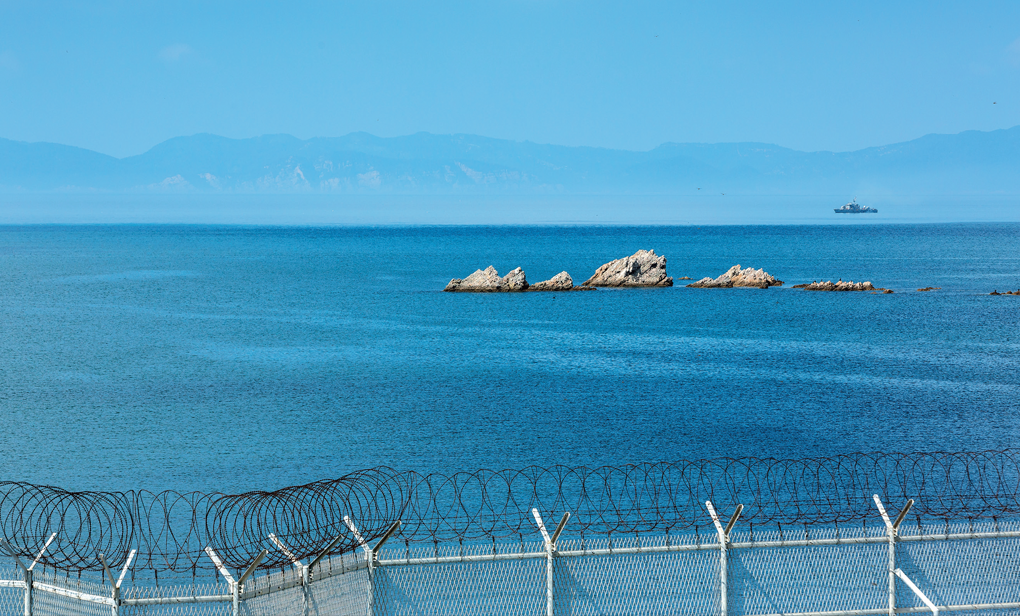
North Korea can be seen beyond the barbed wire fence along the coast of Baengnyeong Island. The most serious military clashes between South and North Korea since the Korean War (1950–53) have taken place in the waters off the island.
Spread of Catholicism
Baengnyeong Island locals believe that Indangsu, the sea which features so prominently in the classical Korean novel “The Story of Sim Cheong” (Sim Cheong jeon), is off the northwestern shore of the island. Sim Cheong, the heroine of the tale, needs 300 sacks of rice to offer to a Buddhist temple so that her blind father can restore his sight. At the time, merchants sailing to Nanjing were searching for a young virgin to sacrifice to the sea gods. They wanted to ensure a safe passage through the treacherous sea, and Sim Cheong volunteers in order to be able to afford the offering. In memory of her filial piety, the islanders built a shrine named after her in Jinchon Village, which faces the sea in the story.
The legendary tale is a product of an anonymous writer’s imagination, but the depiction of the turbulent waters between Baengnyeong Island and Cape Changsan is very real. Rocks and reefs coupled with swirling water d by the collision of currents from the south and north have caused frequent sinkings. The victims include several navy commanders who died in 1771 when their ship sank during military exercises. Hence, King Yeongjo ordered that future training be conducted in two groups north and south of Cape Changsan.
The sea route from the Shandong peninsula in China to the Joseon capital, Hanyang, or Kaesong (Gaeseong), via Baengnyeong Island gained further historical significance due to Kim Taegon, the first Catholic priest from Korea. In 1846, a year after being ordained, he received an order from Jean-Joseph-Jean-Baptiste Ferréol, the third Vicar Apostolic of Korea, to pioneer a West Sea route for missionaries to travel. At the time, Joseon was under Western pressure to open its ports for trade. It reacted by persecuting Catholicism, ruling it a heretical religion.
Kim Taegon (a.k.a. Father Andrew Kim or Father Andrea Kim) traveled from Hanyang to Baengnyeong Island, where he enlisted Chinese fishermen to help him bring French missionaries to Korea. On his return to the capital, Kim was arrested. Three months later, the Joseon government executed the 25-year-old priest. In 1984, he was canonized and named a saint by the Vatican.
There are an unusually large number of churches and cathedrals on the five West Sea islands. On Baengnyeong Island alone, there are 13 churches for a population of some 5,700. Seventy-five percent are believers. Junghwa-dong Church was the second Presbyterian church to be built in Korea. When the Joseon government lifted the bans on evangelism and establishment of churches in 1898, Christians on Baengnyeong Island turned a 40-square-meter school into a church. The Baengnyeong Christian Church History Hall by its side has a permanent exhibition of records of evangelism by missionaries on the island and in nearby areas from the early 19th century.
Cotton Cloth Boom
Before Joseon opened its ports in 1876 under the Treaty of Ganghwa with Japan, the government monopolized trade. However, smuggling was never stamped out. In the early Joseon period, illegal trade occurred through Waegwan (meaning “Japan House”), the government offices set up in coastal towns for trade with Japan, or on Tsushima Island. The main products were silver from Japan and ginseng from Korea. Going into the 19th century, the area around Cape Changsan became the center of smuggling between Chinese and Korean merchants. The primary goods were red ginseng from Joseon and cotton cloth from Qing. The Qing dynasty had endured the Opium Wars against Britain and red ginseng was a popular antidote for opium poisoning. In Joseon, Western cotton cloth was all the rage. The quality of cotton woven on machines in Britain or India was much better than the coarse cotton cloth woven on Korean looms.
Merchants from Kaesong and capitalists from Hanyang competed in the highly lucrative trading of red ginseng for cotton cloth. Smuggling was rife on Baengnyeong and Socheong islands, which had lax security. Later, when the country’s ports were opened, the cotton trade, which had shaken up the Joseon economy, fell into the hands of Japan. Thereafter, everyone forgot that a new trend that changed Korean clothing forever had come over the waters of Baengnyeong Island.
The highlight of any visit to the five West Sea islands is the beautiful scenery. Like Dumujin on Baengnyeong Island, the whole coastline features s of precipitous cliffs. There are also beaches big and firm enough for small planes to land on. Geologists believe that this numinous landscape was formed in the process of three massif blocks, formed during the Precambrian Era, slowly moving over the ages to their current position tothe Korean peninsula. That is, the enormous energy generated by the great collision led to folding and faulting that deformed the Earth’s surface, giving rise to fantastic new rock formations. Recognizing their value, in July this year, the Environment Ministry designated 10 scenic spots on Baengnyeong, Daecheong and Socheong islands as National Geoparks.
In terms of vegetation, thanks to their location, the five West Sea islands are natural gardens for plants from both the south and north. Daecheong Island is not only the northern limit for camellia trees, but it is also of great academic interest as a natural habitat for the vesper iris and thread-leaf chives.
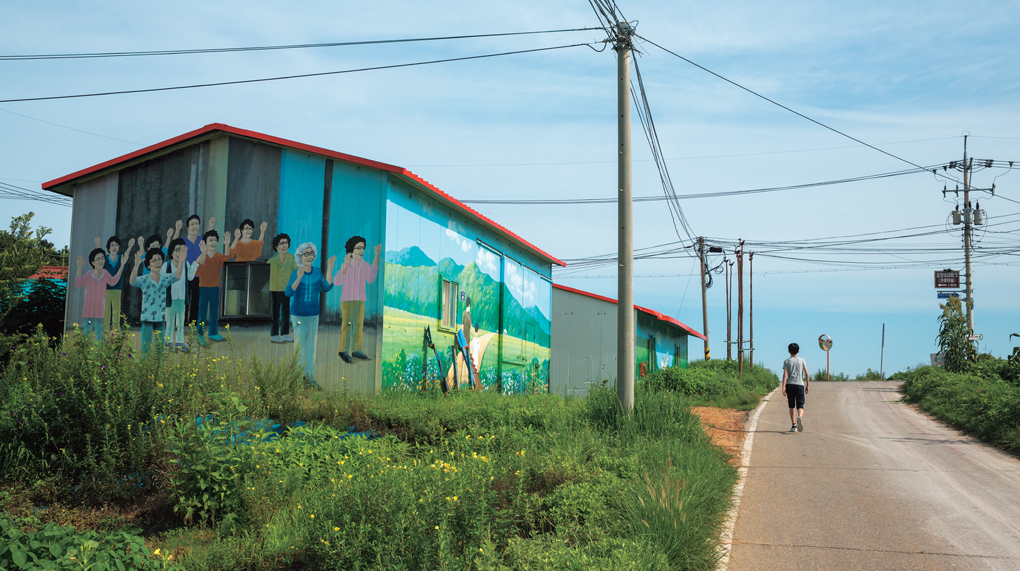
The village of Gwanchang-dong on the northern side of Baengnyeong Island. In the past, merchants trading with China unloaded their cargo on the village docks and stored their goods there.
If any first-time passengers appear both curious and cautious, it is understandable. After all, the ferry is heading straight into the main military flashpoint of the divided Korean peninsula.
Cold Noodles and Dumplings
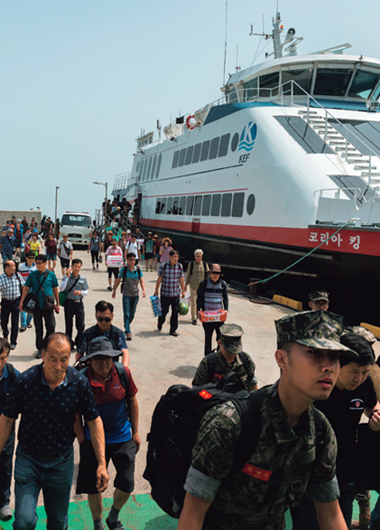
Soldiers returning from holidays, island locals and visitors arrive at Baengnyeong Island after a four-hour ride on a highspeed ferry from Incheon Harbor. The vessels make three round trips a day to the island’s port at Yonggi Harbor.
After sightseeing, it’s time to take a rest and think about lunch. Hwanghae Province-style naengmyeon is made purely with pork broth, unlike the more well-known Pyongyang naengmyeon, which is made with beef broth mixed with chicken, pheasant or pork broth.
Naengmyeon made in the Baengnyeong Island style is based on the rather plain tasting Hwanghae style, seasoned with fish sauce instead of soy sauce. The noodles mostly consist of buckwheat, so they are soft and easy to break. For a complete meal, the cold noodles are eaten with a plate of tender boiled pork slices, hefty Hwanghae dumplings or mung bean pancakes (bindaetteok). Winter visitors can try the seasonal specialty, kimchi tteok, a dumpling-like food stuffed with winter kimchi, oysters and mussels, all local ingredients. The catchphrase “Islands that beckon you to visit and stay a while” hovers at the tip of the tongue.